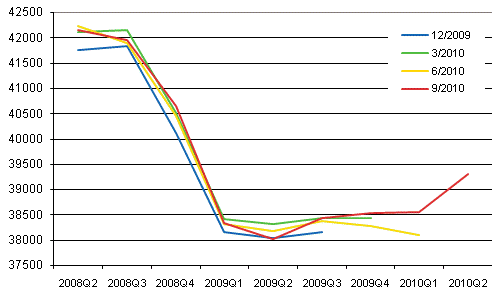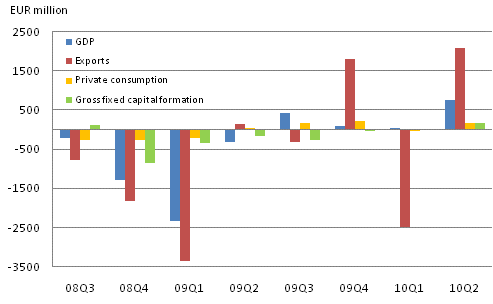1. Exports and investments in residential building pulled Finland's economy to growth in the second quarter
Corrected on 9 September 2010. The correction
is indicated in red. Was previously service industries.
In the second quarter of 2010, the volume of Finland’s gross
domestic product increased by 1.9 per cent from the previous
quarter. Adjusted for working days, gross domestic product was 3.7
per cent up on the second quarter of 2009. Calculated at current
prices, GDP adjusted for working days grew by 5.4 per cent
year-on-year.
The volume of seasonally adjusted GDP peaked in the second quarter of 2008, after which it fell very rapidly especially in the last quarter of 2008 and the first quarter of 2009. The lowest point of the economic downturn seems to set on the second quarter of 2009. After that GDP has been growing again slowly and is now more or less on the same level as in 2006.
Figure 1. Revision of seasonally adjusted volume of GDP in quarterly national accounts publications

Other European economies are also slowly recovering from the economic downturn. According to the preliminary data compiled by Eurostat, in the second quarter of the year GDP grew in the EU area by 1.0 per cent from the previous quarter and by 1.9 per cent year-on-year.
1.1. Output
In primary production, i.e. agriculture, forestry and fishing, the volume of value added was 4.2 per cent higher in the second quarter than in the previous quarter and 17.3 per cent higher than one year earlier. In particular, value added increased in forestry clearly from one year back.
Output in manufacturing grew again in the second quarter after the weak first quarter. Its value added was 3.2 per cent up on the previous quarter and 7.8 per cent up on the respective quarter twelve months back. Growth in manufacturing came primarily from the wood and paper industry, where the value added recorded was 17.9 per cent up on the previous quarter and 21.8 per cent up on the year before. In the metal industry (incl. electrical and electronics industry) value added increased by 6.4 per cent from the previous quarter and by 5.2 per cent from twelve months back. Within the metal industry the growth branches were especially the manufacture of basic metals and building of ships. In other manufacturing value added remained on level with the previous quarter but grew by 3.4 per cent year-on-year.
The volume of value added in construction turned upwards in the second quarter after a long downhill. In the April to June period output increased by 2.8 per cent from the previous quarter and by 5.7 per cent year-on-year.
The value added of service industries grew by 0.8 per cent from the previous quarter and by 1.9 per cent year-on-year. The value added of trade was 2.4 per cent up on the previous quarter and 5.4 per cent up on the respective quarter twelve months back. Transport, storage and communications increased by 2.7 per cent from the previous quarter and by 6.2 per cent from one year back. The value added of real estate and business activities went up by 0.4 per cent from the quarter before but fell by 0.5 per cent year-on-year.
The added up volume of value added of all industries grew by two per cent from the previous quarter and by 3.8 per cent from twelve months back.
1.2. Imports, exports, consumption and investments
Total demand grew by 2.8 per cent from the previous quarter and by 3.7 per cent year-on-year. Exports and investments in residential building particularly increased demand.
Figure 2. GDP and expenditure components, change from previous quarter (seasonally adjusted, at reference year 2000 prices)

In the second quarter, the volume of exports grew by 12.6 per cent from the previous quarter and by 6.1 per cent year-on-year. The labour dispute in stevedoring in March makes comparisons with the previous quarter difficult. Exports of goods increased by 16.2 per cent and those of services by 3.4 per cent from the previous quarter. The volume of imports grew by 6.6 per cent from the previous quarter and was 3.7 per cent higher than twelve months back. Imports of goods went up by 7.8 per cent but imports of services diminished by 1.2 per cent from the previous quarter.
Revisions put the change in imports (goods and services together) in the first quarter at -4.4 per cent from the previous quarter and at -5.9 per cent from twelve months back, whereas in the previous release the respective figures were -2.7 and -4.5 per cent. The change in the volume of exports in the first quarter became revised to -13.1 per cent from the previous quarter and to -5 per cent from the year before, while the respective change percentages published in the previous release were -11 and -2.2 per cent. Data on imports and exports may become substantially revised.
In the second quarter, the volume of private consumption grew by 0.8 per cent from the previous quarter and by 2.6 per cent from twelve months back. Purchases of durable goods increased considerably in the second quarter, as motor vehicle sales picked up and more home electronics were acquired apparently instigated by the World Cup in football. The volume of public consumption expenditure fell when compared both with the previous quarter and the same quarter twelve months back.
In the second quarter, the volume of investments grew by 2.5 per cent from the previous quarter and by 0.6 per cent from twelve months back. Construction investments increased by 3.5 per cent from the previous quarter and by 6.6 per cent year-on-year. In the second quarter investments in residential building were growing strongly as the volume rose by 11.4 per cent from the previous quarter and by 33.5 per cent year-on-year. The volume of investments in machinery, equipment and transport equipment contracted by 3.8 per cent from the previous quarter and by 11.1 per cent year-on-year. Private investments increased by 2.5 per cent from the previous quarter, but public investments declined by 1.1 per cent.
1.3. Employment, wages and salaries and national income
No essential changes took place in the employment situation in the second quarter. The number of employed persons went up by 0.4 per cent from the previous quarter but was 0.4 per cent lower than one year previously. The number of hours worked in the national economy increased by 0.3 per cent from the previous quarter and by 1.9 per cent from one year back. Hours worked in manufacturing and trade in particular have increased from one year ago, which in manufacturing is probably due to the lower number of temporary lay-offs and in trade to longer opening hours. The quarter had one working day less than one year ago.
According to Statistics Finland’s Labour Force Survey, the unemployment rate for the April to June period was 9.6 per cent. In the corresponding period of last year the unemployment rate was the same.
In the April to June period the nominal wages and salaries bill (excluding incentive stock options) of the national economy increased by 1.1 per cent from the previous quarter and by 2.4 per cent year-on-year. The operating surplus (net), which in business bookkeeping corresponds roughly with business profit, grew by 29 per cent at current prices from twelve months back. Gross national income calculated at current prices was 5.3 per cent higher than one year previously.
1.4. The available data
These preliminary data on the second quarter of 2010 are based on the information on economic development that had become available by 26 August 2010.
Data at the annual level correspond with the National Accounts data released on 15 July 2010. Data on the third quarter of 2010 will be released on 9 December 2010, when the data for previous quarters will also be revised. Quarterly data continue to be revised until final annual accounts data are published at the lag of around two years. Seasonally adjusted time series always become revised against new observations irrespective of whether the original time series becomes revised or not.
The new calculation methods of quarterly national accounts are elaborated upon in a separate methodological release: http://tilastokeskus.fi/til/ntp/men_en.html
A level shift was added to the seasonal adjustment model of the value added series of trade (G) at reference year prices for the first quarter of 2009 due to revisions in annual national accounts. Further information on the seasonal adjustment method: http://tilastokeskus.fi/til/tramo_seats_en.html
Source: National Accounts 2010, 2nd quarter. Statistics Finland
Inquiries: Pasi Koikkalainen (09) 1734 3332, Samu Hakala (09) 1734 3756, kansantalous.suhdanteet@stat.fi
Director in charge: Ari Tyrkkö
Updated 8.9.2010
Official Statistics of Finland (OSF):
Quarterly national accounts [e-publication].
ISSN=1797-9765. 2nd quarter 2010,
1. Exports and investments in residential building pulled Finland's economy to growth in the second quarter
. Helsinki: Statistics Finland [referred: 15.12.2025].
Access method: http://stat.fi/til/ntp/2010/02/ntp_2010_02_2010-09-08_kat_001_en.html

